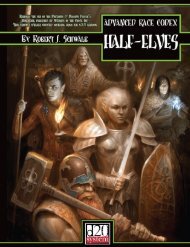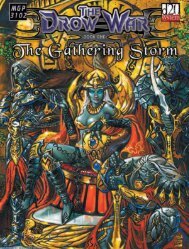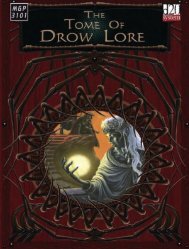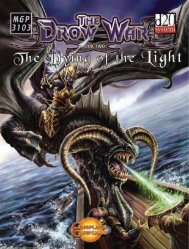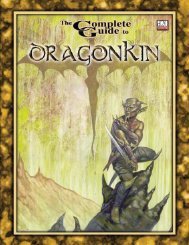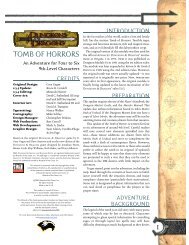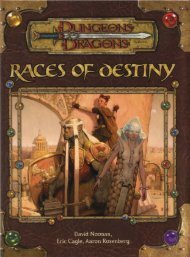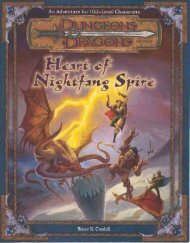Drow Magic. Sorcery Of Endless Night.pdf - RoseRed
Drow Magic. Sorcery Of Endless Night.pdf - RoseRed
Drow Magic. Sorcery Of Endless Night.pdf - RoseRed
Create successful ePaper yourself
Turn your PDF publications into a flip-book with our unique Google optimized e-Paper software.
BLACK CEREMONIES<br />
purely concrete mechanical bonuses and penalties.<br />
While those sorts of effects are unarguably easier to<br />
resolve in game and should not, by any means, be<br />
avoided, they are perhaps the less interesting of the<br />
effects which ceremonial magic can create. As has been<br />
said before, the guidelines for creating and resolving<br />
the use of ceremonial magic are generalised and open<br />
to interpretation. So while the actual steps required<br />
to create ceremonial magic are laid out in a rather<br />
specific step by step process, the list of possible effects<br />
is intentionally broad. In that respect, the effects which<br />
can be created with ceremony magic are rather like the<br />
powers of an artefact – mysterious and far reaching, but<br />
backed by a solid framework of rules. Perhaps the best<br />
effects for ceremonial magic are those which combine<br />
mechanical effects with more freeform effects – the<br />
black dawn ceremony, for example, imposes attribute<br />
and morale penalties on all surface dwelling beings,<br />
particularly elves, while simultaneously turning the sun<br />
the colour of dried blood for all eternity.<br />
Effect Types<br />
Since the final effect of a ceremony can be nearly<br />
anything, by necessity the following categories of<br />
effects must be kept intentionally broad. With that<br />
in mind, the following categories encompass the most<br />
commonly chosen ceremony effects. A ceremony can<br />
have more than one effect, though each additional effect<br />
adds considerable difficulty to the ritual.<br />
Each of the following effects categories has an<br />
associated DC. This DC is the base DC of the<br />
ceremony, which will be modified by casting time,<br />
components and the like (as described below). The<br />
DC of the effect is not associated with a specific skill.<br />
The skill which will be associated with the ceremony<br />
is chosen by the Games Master, with assistance and<br />
suggestions from the player (if one is creating a ritual)<br />
highly encouraged.<br />
While a clever Games Master or player can undoubtedly<br />
devise a ceremony for every single skill in Core<br />
Rulebook I, there are certain skills which are more<br />
appropriate for ceremonial magic than others. The<br />
skills most commonly associated with ceremony<br />
magic are Craft (any, but in particular armoursmith<br />
and weaponsmith), Knowledge (any, but most often<br />
arcana, architecture, history, nature or religion),<br />
Perform (any, but most often dance, chant, oration or<br />
song) and Profession (any, but most often farmer and<br />
other agriculture based professions). In general, only<br />
one skill will be associated with the base DC of the<br />
ceremony, though certain options presented below will<br />
48<br />
Base DCs and the Lowering and Raising<br />
Thereof<br />
The base DC of a ceremonial effect represents<br />
the minimum difficulty which must be overcome<br />
to successfully perform the ritual. While there is<br />
no effective limit to how high the DC of a magic<br />
ceremony can be raised, there is a limit to how much<br />
it can be lowered; the DC of a magical ceremony can<br />
never be lowered below one half the starting base<br />
DC of the effect to be brought about. In the case of<br />
a magical ceremony with more than one effect, the<br />
DC can never be lowered below the sum total of one<br />
half the base of the highest DC effect and one quarter<br />
the base of each of the other effects.<br />
require the association of a second or even third skill<br />
with the base DC.<br />
Bolstering and Weakening (DC 30+)<br />
<strong>Magic</strong>al ceremonies which enhance or reduce the<br />
physical, mental or spiritual attributes of living<br />
things, objects or concepts are considered to be using<br />
bolstering or weakening effects. For example, the<br />
black ceremony war, which increases the savagery<br />
and combat prowess of an entire city-state’s worth of<br />
drow warriors by leaching strength from their enemies,<br />
is both a bolstering and weakening effect. Likewise,<br />
a ceremony which weakens the concept of sunlight<br />
so that it is no longer harmful to drow is a weakening<br />
effect. The base DC of a bolstering or weakening effect<br />
varies, as outlined below:<br />
Raise or Lower Attributes: DC 30 + 3x the total<br />
number of attribute points raised or lowered. +2 for<br />
each attribute raised after the first.<br />
Hardness: DC 30 + 3x the total number of hardness<br />
points raised or lowered.<br />
Crop Production: DC 45.<br />
Concept bolstering or weakening: DC 30 – 60. This<br />
effect can be used to halve the destructive potential of<br />
fire, or to increase the darkness of midnight by twofold,<br />
for example.<br />
The bolstering and weakening effect is perhaps the<br />
most open ended of all ceremonial magic effects.<br />
What constitutes the bolstering of a god in battle<br />
with another god and what exactly happens when the<br />
black ceremony boundless sorrow weakens the will of<br />
the surface elves is a matter of interpretation. When<br />
determining the results of such open to interpretation<br />
effects, the Games Master has final say, though he is of<br />
course encouraged to take the player’s intentions into




